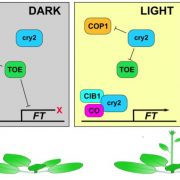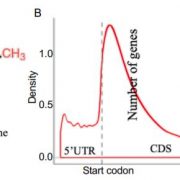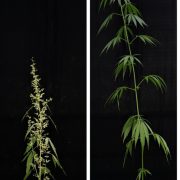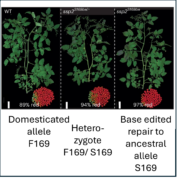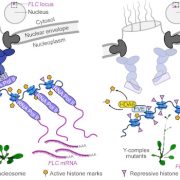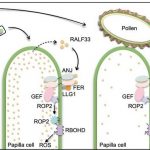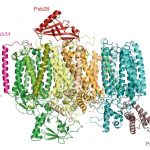DELLA degradation by gibberellin promotes flowering via GAF1-TPR-dependent repression of floral repressors in Arabidopsis (Plant Cell)
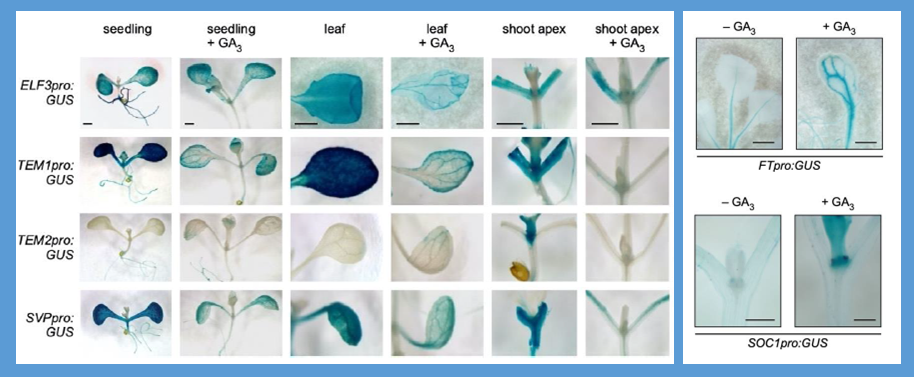 In Arabidopsis, flowering is promoted by the activation of the florigen FT in response to long days and by the accumulation of the phytohormone GA under short days (SD). Despite the extensive knowledge of regulatory networks involving FT, the molecular mechanism controlled by GA is still unresolved. Fukazawa and coworkers previously identified GAI-ASSOCIATED FACTOR1 (GAF1), a transcription factor that interacts with the growth repressors DELLA and the corepressor TOPLESS RELATED (TPR), and found that GAs convert the GAF1 complex from a transcriptional activator to a repressor via the degradation of DELLAs. In addition, they proposed a specific role for GAF1 in the regulation of flowering mediated by GA, supported by the late flowering phenotype of gaf1 mutants under SD. In this study, the authors used RNA-sequencing to identify GAF1 targets and found mis-regulation of ELF3, SVP and TEM1/TEM2 genes, which encode important floral repressors. Specifically, these flowering time genes were downregulated upon GAF1 induction and their regulatory sequences were directly bound by GAF1. Furthermore, application of GAs caused significant reduction of ELF3, SVP and TEM1/TEM2 expression in wildtypes but not in gaf1 mutants. Taken together, these findings suggested that GAs cause downregulation of GAF1 target genes, which leads to the induction of FT in the leaf and SOC1 in the shoot apical meristem. To recap, GAF1 forms a repressor complex with TRP in response to accumulation of GAs, which occurs shortly before the floral transition under SD, that switches off key floral repressors and switches on floral integrators. (Summary and image adaptation by Michela Osnato @michela_osnato) Plant Cell 10.1093/plcell/koab102
In Arabidopsis, flowering is promoted by the activation of the florigen FT in response to long days and by the accumulation of the phytohormone GA under short days (SD). Despite the extensive knowledge of regulatory networks involving FT, the molecular mechanism controlled by GA is still unresolved. Fukazawa and coworkers previously identified GAI-ASSOCIATED FACTOR1 (GAF1), a transcription factor that interacts with the growth repressors DELLA and the corepressor TOPLESS RELATED (TPR), and found that GAs convert the GAF1 complex from a transcriptional activator to a repressor via the degradation of DELLAs. In addition, they proposed a specific role for GAF1 in the regulation of flowering mediated by GA, supported by the late flowering phenotype of gaf1 mutants under SD. In this study, the authors used RNA-sequencing to identify GAF1 targets and found mis-regulation of ELF3, SVP and TEM1/TEM2 genes, which encode important floral repressors. Specifically, these flowering time genes were downregulated upon GAF1 induction and their regulatory sequences were directly bound by GAF1. Furthermore, application of GAs caused significant reduction of ELF3, SVP and TEM1/TEM2 expression in wildtypes but not in gaf1 mutants. Taken together, these findings suggested that GAs cause downregulation of GAF1 target genes, which leads to the induction of FT in the leaf and SOC1 in the shoot apical meristem. To recap, GAF1 forms a repressor complex with TRP in response to accumulation of GAs, which occurs shortly before the floral transition under SD, that switches off key floral repressors and switches on floral integrators. (Summary and image adaptation by Michela Osnato @michela_osnato) Plant Cell 10.1093/plcell/koab102


